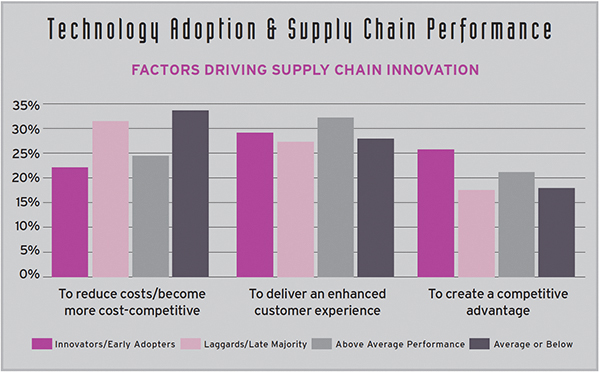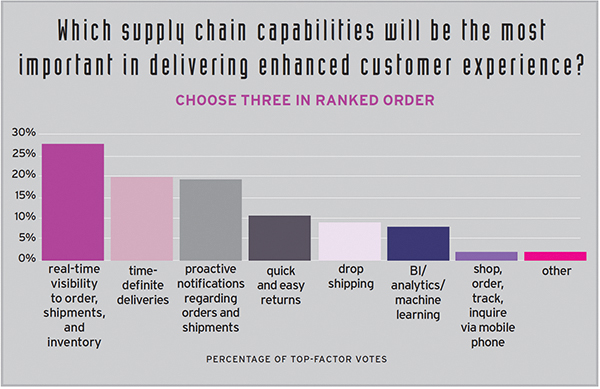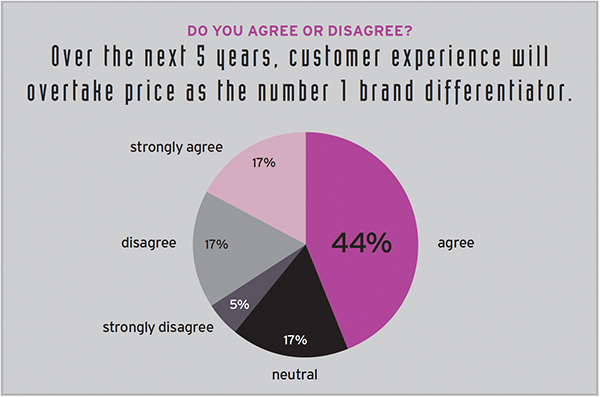The CX Files

The truth is out there. Technology tools offer mindbending ways to delight retailers and their customers. And there’s no conspiracy about that.
To stand out in the market, a company needs more than great products at great prices. It also must deliver excellent customer service. Among other things, that means having products in stock when customers want them; making it easy to conduct transactions; offering detailed information about products; providing quick, convenient delivery; and keeping customers informed about the progress of their orders.
Over the next five years, customer experience will overtake product and price as the main differentiator among brands, according to 61% of shippers and logistics service providers surveyed in 2019 by BluJay Solutions, Adelante SCM, and the Council of Supply Chain Management Professionals (see charts).
With that evolution in mind, companies are investing in technologies that enhance customer service. "That’s a new trend," says Patrick Maley, chief marketing officer at BluJay, a supply chain software and services vendor based in Chelmsford, Massachusetts. "Typically, the reason for investment has always been raising productivity and lowering costs."
Will customer experience (CX) overtake price and product as the top brand differentiator? Which supply chain capabilities will be most important in delivering an enhanced CX? The charts reveal some key findings from "Focus on Customer Experience: Research on Supply Chain Priorities and Investments," a survey commissioned by BluJay and conducted by Adelante SCM and the Council of Supply Chain Management Professionals.
Visibility and Analytics
Capabilities that do most to produce a good customer experience, according to the survey, include: real-time visibility to orders, shipments, and inventory; time-definite deliveries; proactive notifications regarding orders and shipments; and quick and easy returns. When respondents invest in technology these days, the survey says, their top two focus areas are visibility and analytics, both of which provide customer service benefits.
"Whether it’s in the B2C (business-to-consumer) or B2B (business-to-business) world, companies want to give people visibility to their shipments and orders, and the ability to change their orders—self-service capabilities," Maley says.
Analytics help companies divide customers, orders, and issues into segments, to reveal where their customer service problems lie. "The way our own customers look at our data and analytics helps them understand where they’re falling down on delivering in full and on time," Maley says.
One of the first opportunities to provide outstanding customer service is when a customer places an order. This is just as true in the B2B market as in B2C. Now that many B2B companies have added e-commerce channels, customers expect the same quality of service online as when they work with sales representatives.
"It’s about emulating the relationship and roles of the account rep, but doing so with the tools and technologies at your disposal," says John Bruno, vice president of product management at e-commerce technology firm Elastic Path in Vancouver, British Columbia.
So, for instance, when an electrician logs into a distributor’s e-commerce site, the site should know him well enough to display only products relevant to electrical work, not equipment for plumbing or heating.
The site should also personalize pricing. If the merchant offers its biggest customers a 10% discount on all purchases, those buyers should see the discounted prices when they visit the site. If it offers a discount on only the 100 items a company buys routinely, the merchant should be able to tailor the prices displayed for just those items, without producing a separate online catalog for each customer.
A B2B e-commerce site could also streamline transactions for companies that don’t give all their employees the same purchasing authority. In the manual world, buyers would have to route purchase orders around the office for approvals. In the digital world, when a purchase required a signoff, the e-commerce platform could automatically notify the person with the right authority.
"The approver hits ‘Approve,’ and now you’re firing on all cylinders," Bruno says.
A seller could also design its platform to offer a different customer experience to different buyers within one company. That could mean presenting a distinct face to customers on different continents. But other strategies are possible, too.
"If I’m U.S.-only but sell to a company that has three different brands, and they have three different purchasing departments, I might want to organize by those three brands rather than by a geographic area," Bruno says.
The bottom line is customized service. "The ability to create different views of the catalog is where the rubber meets the road for B2B," he adds.
How it’s doing, where it’s been
Some visibility tools tell customers whether their orders are moving toward them on time. Others serve customers by helping to protect product integrity.
That’s the case with rfxcel, a software system that tracks products as they move through the supply chain. It also allows companies to trace the past movements of finished goods or components.
For example, a food processing company might use rfxcel’s technology to track individual lots of potatoes, carrots, and flour used to make soup. One day, a consumer calls the company to complain about what appear to be insect parts in a can of chowder.
"You can trace the soup all the way back through the supply chain," says Herb Wong, vice president, marketing at rfxcel, based in Reno, Nevada. If the company discovers that a bag of flour was contaminated, it can use the track-and-trace technology to identify and recall every can of soup with flour from that bag, thus protecting retailers and consumers.
rfxcel also works in conjunction with Internet of Things (IoT) devices that measure temperature, humidity, or shock, or track location, to enhance customer service through good supply chain management.
Wong describes how this technology helped one manufacturer protect a temperature-sensitive pharmaceutical product that was accidentally routed through an airport with no proper holding facilities. Thanks to a GPS device, the shipper could see that the load was headed to the wrong location. The shipper then notified its third-party logistics provider.
"We showed them the log and, sure enough, the goods had diverted and no one knew," Wong says. "Had it not been for a system that could independently verify this, those drugs might have been at risk for damage."
Another time, rfxcel’s system showed a pallet load of pharmaceuticals sitting on an airport tarmac, rather than in temperature-controlled storage. "The shipper called the airport, and then watched in real time as the item moved off the tarmac into the storage facility," Wong says.
We know who you are
B2C merchants deliver customer service through many more channels than they used to—not just in person or on the phone, but through interactive voice response and chatbots, online, through e-mail, or on social media. Often, data related to each interaction stays trapped in a single channel. So when, for example, a consumer calls a customer service center, the agent who responds might have no idea what the customer bought last week in the store or discussed yesterday with a chatbot.
Each time that consumer makes contact, she needs to repeat her details and retell her story. That’s not what consumers want. "They want you to get to the bottom of the issue right away," says Karthik Marudur, director of product management at supply chain and omnichannel technology vendor Manhattan Associates in Atlanta. And they want every channel to have access to all their details.
In e-commerce, shoppers also want a customer experience tailored to their interests and shopping habits. "If the customer is more keen on seeing items on sale, they want those to be shown first," Marudur says. "If they’re an omnichannel customer, the different delivery options are a priority for them."
To achieve this personalized service, some retailers are integrating their call center management systems, workforce management systems, and systems that manage customer transactions. With help from technology developers such as Manhattan Associates, merchants are also adding case management, creating a single record for all interactions with a customer, through any channel.
Ideally, retailers should make routine customer self-service as simple as a chat with a voice-based virtual assistant. "Have your associates trained in the software that brings all the information together," says Marudur. "So when the customer does have a question and tries to reach out, associates have the answers at their fingertips and can get on it right away."
Delivery often becomes a crucial component of customer service. Companies that sell smaller items may rely on conventional package delivery or courier services. Those that sell furniture or other large products need different solutions.
Brilliant Strategy
At Bob’s Discount Furniture, a chain with stores in 18 states across the United States, the home delivery solution is the online platform Brilliant Move. Based in the Boston area, Brilliant Move currently operates in five states, with plans to expand. Right now, customers at 13 of Bob’s outlet stores in the Northeast can use Brilliant Move to schedule transportation.
"This is a new service that was previously not offered to our customers," says Pete Sorrentino, vice president of delivery operations and outbound logistics at Bob’s Discount Furniture, headquartered in Manchester, Connecticut. At outlets where Brilliant Move is not available, customers transport purchases themselves or make other private arrangements.
In each market where it operates, Brilliant Move has assembled a network of experienced moving companies to transport large items for customers, says company founder Jean Brillant. When a customer at Bob’s or another participating store buys an item, the retailer directs them to an app to schedule a move. The customer specifies where to pick up and deliver the item, and when.
The software calculates a fee for each delivery, with revenues split between the moving company and Brilliant Move. The retailer pays nothing.
The customer receives notifications at various points in the delivery and can use the app to follow the driver’s progress. Drivers and customers can also call or text one another through the app.
"There has been a growing ‘ask’ for delivery service, especially in our urban and suburban outlet stores," says Sorrentino. Brilliant Move helps Bob’s meet that need.
Besides making life easier for customers, Brilliant Move can give retailers new supply chain management options, says Brillant. For instance, omnichannel merchants could use the platform to have products delivered from stores close to their customers, rather than from fulfillment centers.
That reduces delivery time. "It should also help with reducing average inventory on hand," Brillant says. "It should help with better forecasting. And we see it also as a way of cutting down on shipment costs."
Know it all
When customers hunger for information about products offered in brick-and-mortar stores, LocatorX in Atlanta offers to satisfy their desire.
The company helps manufacturers and other supply chain players mark products with Quick Response codes, or with tags that transmit data via near-field communications or Bluetooth technology. Scan one of those tags, and your phone reveals a storehouse of data about not just the product, but the individual unit.
For the consumer, that display can verify, for instance, that the designer briefcase in her hands is not a counterfeit, or that a moisturizing lotion was manufactured safely. "Consumers increasingly want to have visibility that they have a certified product," says Pat Pickren, vice president of product at LocatorX.
A product’s "connect page" might also enhance the customer experience by displaying product instructions, or coupons for future purchases. And companies can tailor displays for individual consumers. For instance, "They can serve up information in a person’s own language," says Billy Meadow, LocatorX’s founder and chief technology officer.
That easy access to information translates into better customer service. "If you want to know anything about a product, you simply point your phone and scan it," Meadow says.
Besides linking consumers to abundant information, LocatorX’s technology can help companies monitor products—whether single units or pallet loads—as part of a supply chain management strategy.
The technology might also help companies gain more insight into what customers want, by monitoring when, where, and why customers scan their products.
When customers scan bottles of barbecue sauce, for instance, do they typically use the connect page to see the ingredients or to find recipes? "That can help with product placement," Meadow explains. "It can help with certain call-to-action campaigns."
And, like many other technology tools, it can help companies distinguish themselves by delivering the outstanding customer service that buyers crave.



